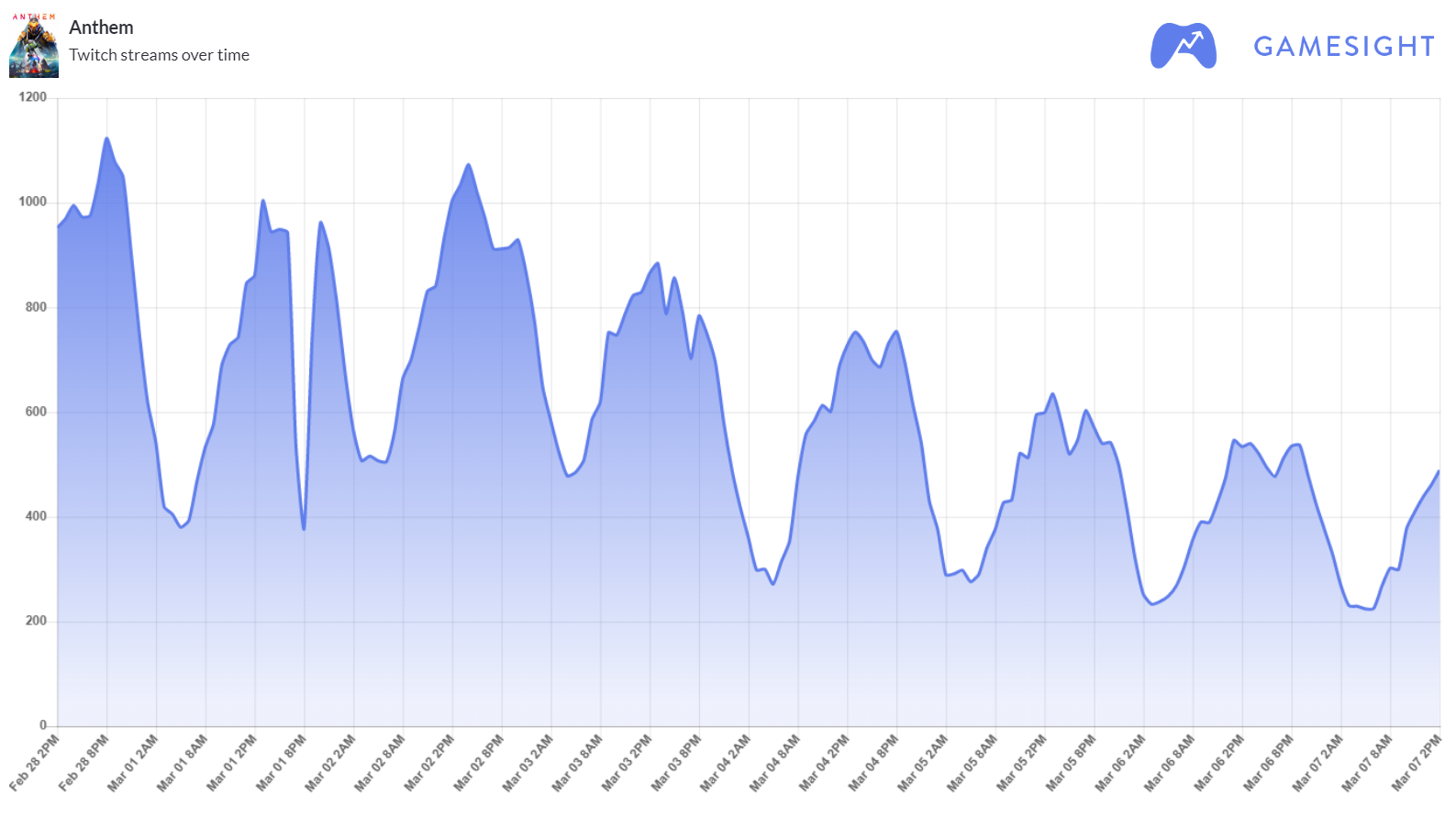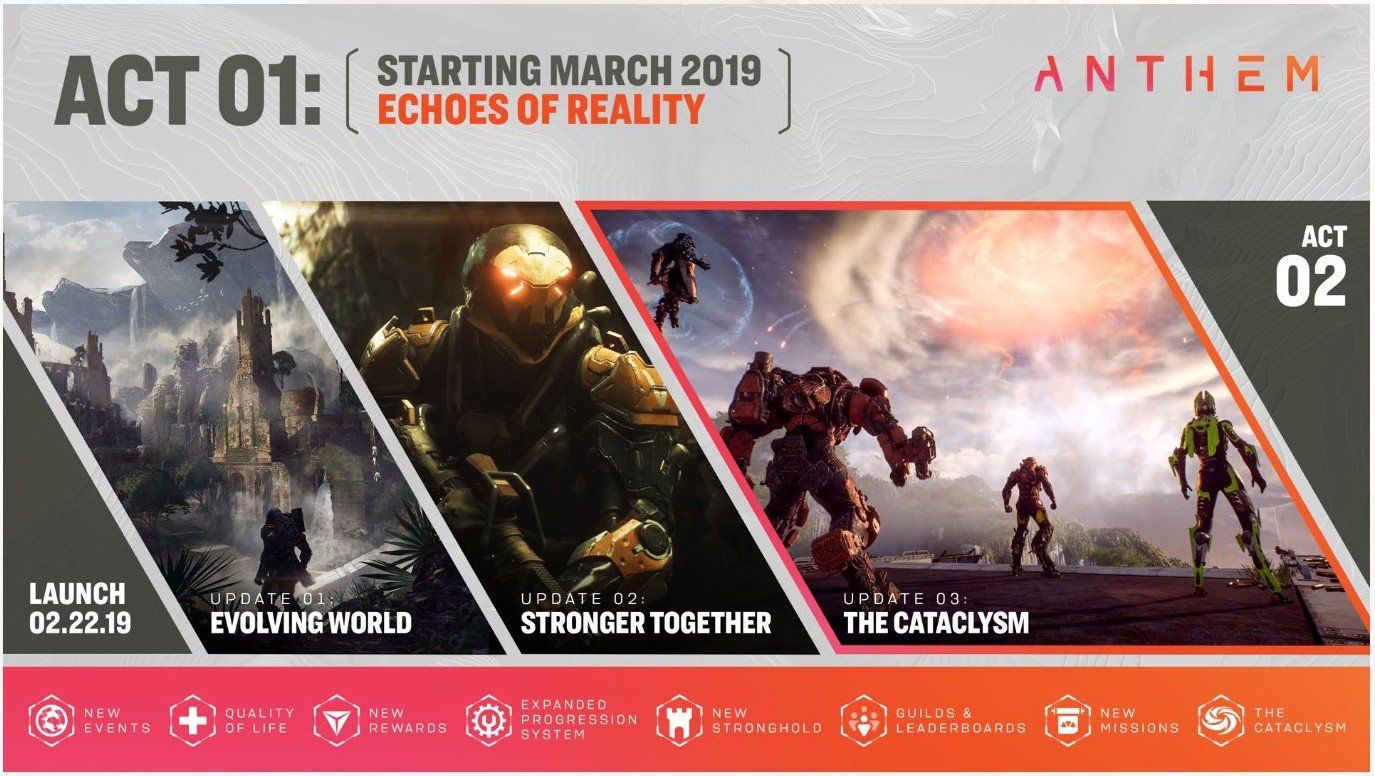Anthem: Explaining its Troubled Start and Hopeful Future
So, how did we get here? Why is Anthem struggling, and what can it do to reverse its momentum? Let’s break it down.

When Anthem was announced way back in June of 2017, it quickly emerged as one of the big titles on the horizon. The appeal of combining Bioware’s renowned storytelling prowess with an open-world action loot-shooter built on intense action and even freakin’ jetpacks was hard to deny. In a world of more and more always-online shooters, Anthem felt like it had the talent behind it to deliver something truly fresh to the genre, something that could capture the hearts and minds of Destiny and Warframe fans, becoming a fixture for years to come.
Now, here we are. Anthem has been available, in full, for about three weeks, now, and already we have to ask ourselves: is it going to survive? On March 6th, Anthem was streamed on a peak of 546 channels, approximately the same as the game it was meant to supplant, Destiny 2, averages now, 18 months after its release. That was the lowest such number for Anthem since it became available, and the trend is still pointing down.

So, how did we get here? Why is Anthem struggling, and what can it do to reverse its momentum? Let’s break it down.
Square Peg, Round Hole
There’s a very clear picture, in the gaming community of what constitutes a “Bioware Story.” For nearly a decade and a half, the developer has been behind one after another of the most captivating, engrossing, complex narrative experiences in the interactive space. Early examples like the tabletop-inspired Baldur’s Gate and Icewind Dale eventually gave way to expansive RPGs like Knights of the Old Republic and the Mass Effect series. All of these titles have set the standard for what can be accomplished, narratively, through a video game. They feature richly detailed worlds, complex characters, meaningful choices, and fantastic, exhilarating arcs.
All of these things are at odds with the nature of the looter-shooter genre.

Anthem and titles like it feature open worlds with cooperative gameplay. You’re supposed to be teaming up with other people, fighting large battles and looting lairs or dungeons. All of this makes it very difficult to tell a personal, individual story for your character. You can’t be given choices that matter, because any substantial changes to the setting as a result would have to be shared by all the other players. That’s why story often takes a backseat in games like this, instead replaced by opportunities to build lore, to color in the history of the world and characters within it through unique items, logs, and records.
That’s not to say that Anthem’s story is bad; its broad strokes are similar enough to games like Destiny, and there are a fair number of side characters with rich backstories and interesting nuance. But, this is a Bioware game. That means fans are expecting a “Bioware Story,” and what they find doesn’t really meet that standard. This particular developer throwing their hat into this ring brings with it certain expectations, expectations which are perfectly reasonable given their history. Bioware has gone out and delivered a decidedly un-Bioware experience, and it appears to have alienated those who wouldn’t normally play in this genre, but were watching because of who was involved. When a reputation is so strong, you have to lean into it, or be explicit about how much you’re breaking your own mold. Otherwise, you end up surprising people in the wrong way.
Some Publicity Really Is Bad Publicity

When streamers first got their hands on the limited-access demo for Anthem, way back in January, they were met with the server and stability issues many have come to expect from the initial tests of a live ‘game-as-service” product. While it’s hardly a good look to have big-audience streamers sitting on login screens, waiting for the game to become accessible, this did little to mitigate the enthusiasm of the viewing public, who patiently sat in chats with their communities until the bugs were eventually worked out and streamers could get into the game.
Again, problems like that are normal, and a big reason why there were so many of these “tests,” with a second public demo after the aforementioned private iteration, and a full week of early access for a smaller population of players prior to the game’s full release. Players and viewers of games in this genre have come to accept that a certain number of technical issues at launch is just par for the course. But, the audience also expects that issues, be they technical or pertaining to gameplay balancing, are acknowledged and addressed by the game’s team, with a constant stream of updates constantly tweaking and correcting the game in the right direction.
While some of the technical issues that plagued the demo and early access period were addressed via a day one patch, many issues remained, with users also reporting new problems caused by the quick fix. From that point forward, there have been a string of problems, both in and outside the game, that have earned it unflattering headlines. An unpatched bug made the most basic weapons the most powerful in the game. A player and streamer was banned simply doing something that players in the genre have always done. And, in the most problematic controversy, a widespread glitch was causing consoles to crash and, according to some unconfirmed reports, even leaving them ‘bricked,’ or wholly inoperable.
Now, are these particularly daunting challenges? Of course. And by no means are they necessarily the result of any lack of foresight or awareness on the Anthem team’s part. Launching and updating any live-service title is a challenge, and bugs and glitches will always happen. The issue isn’t that these problems have occurred, but rather that there hasn’t been a strong enough effort to engage with the game’s community to discuss and rectify them.
When the story about the console-crashing bug emerged, it took more than two days for players to receive a substantial response. They were simply told that the issue was being “investigated.” In the meantime, gamers were literally afraid that booting up the game would break their console, irreparably. It’s totally understandable that the team at EA or Bioware would want to get to the bottom of the issue first before making any additional statements, but you can’t go silent for two days and not expect the stories and rumors to take on a life of their own. Community managers needed to be there, in Discord servers, in forums, tweeting constantly, talking about how they knew the issue was being looked at and that there would be support for anyone who experienced the problem. At the very least this would make the community feel heard, and it also would give the team the opportunity to mitigate unsubstantiated rumor and insinuation, to try and keep misinformation under control. Eventually, it was apparently found that the issue wasn’t actually bricking consoles at all, but how many headlines and reddit threads were out there, by that point, indicating otherwise? The impact on the game’s foothold on Twitch is clear in the image below, with total streams dropping nearly in half.

Bioware and EA wanted the mood around this game to be one of excitement, both for the admittedly exhilarating experience of jetpacking across the game world and for what the future holds, the promise of more content and events. Instead, the word most of us would use to describe the launch of Anthem would be ‘troubled.’ When every headline is about fixing an old problem or discovering a new one, it’s hard for anything else, from great stream highlights to promises of more content in the future, to break through. It takes an enormous amount of active work to keep the narrative of your game under control, to get in front of problems, to keep your community engaged through the difficult times. Thus far, the team behind Anthem has struggled to do that.
What Next?

So how does the Anthem team make sure the title outlasts these challenges and finds a sustainable long-term plan? Well, the first thing they have to do is really engage with the community they already have.
Around 500 creators are still streaming Anthem, at its peak, every day. That represents your bedrock, your foundation, and these creators need to be made to feel special, to feel like they’re at the center of something new and exciting that will grow around them. Community Investment is the name of the game. The more you can do to galvanize viewership around the people who already have demonstrated a real and substantial liking for your title, the more likely it’ll be that those communities can become self sustaining, can become vital tools at your disposal for every update, content release, hot fix, and expansion.
It’s also vital that, through that community engagement, the team effectively listens and responds to constructive criticism, feedback, and bug/glitch reporting in a way that makes the audience feel like they’re always being heard, and their issues are being addressed. Again, bugs and glitches happen, doubly so in a constantly changing ‘live-service.’ What’s important is that, through every means at their disposal, the Anthem team makes it clear that they are working on every issue they can, as hard as they can, to deliver the best experience possible, and it’s because they love this game and they want you to love it too.
Through those two things and a healthy schedule of regular content updates, Anthem can overcome its slow start. It won’t be able to recapture the excitement of the game’s release, and, so, explosive quick growth is less likely, but, if they can really build out that core group of streamers, lay the foundation, they can gradually grow the game’s presence at a natural pace, and eventually carve out a solid niche on the platform. It’s far from over for Anthem; the game’s got a lot more in the tank and many miles ahead before it reaches its destination. But, what that destination will be depends on how they respond to the challenges that lie ahead of them right now. I think they can make it happen.
Follow us on Twitter and LinkedIn for all the latest blogs, announcements, and game marketing news from the team at GAMESIGHT!

